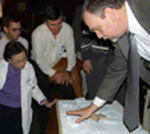Budget, hospital plans top agenda
by Cindy AbolePublic Relations
Budget improvements and the latest plans for MUSC's new hospital topped the agenda of MUSC President Ray Greenberg’s first town hall faculty meeting for 2003 held on Feb. 5.
 Faculty
listen as Byron Edwards from LS3P Associates, one of two architectural
firms involved in the building design, describes the layout for Phase
1 of the hospital replacement plan.
Faculty
listen as Byron Edwards from LS3P Associates, one of two architectural
firms involved in the building design, describes the layout for Phase
1 of the hospital replacement plan.
After offering a quiet moment in remembrance of one-time MUSC physician resident and Columbia shuttle astronaut David Brown, M.D., Greenberg introduced several speakers who presented financial updates of the university, the medical center and University Medical Associates.
The university’s chief financial officer Patrick J. Wamsley reported that despite a steady decrease in state appropriations, MUSC was able to hold its own. Even after the 5 percent budget cut that occurred in December, MUSC is in the black by $2.5 million.
“The good news is that we’ve survived the budget cut and still balanced our budget thanks to management of all departments for helping us in this effort,” Wamsley said. “This good news is attributed to the work of good management, efficiency and our activity in tapping new resources.”
He attributed these benefits to additional sponsored research, an increase in tuition and fees, more philanthropy and a hiring freeze.
The Medical University Hospital Authority echoed similar good news bouncing back from a combined deficit of $28 million in 1998 and 1999 to a positive net income of $10 million in 2002, and $5.3 million through the first half of the current fiscal year.
“We’ve made a lot of progress thanks to faculty and staff for working so diligently to increase the bottom line,” said Lisa Montgomery, MUHA administrator of financial services.
Montgomery reminded the audience of the hospital’s need to generate more cash reserves in order to finance the construction of a replacement hospital.
“Generating cash is our biggest challenge right now as we plan for a new replacement hospital,” Greenberg said. “We’ve had three good years, but we really haven’t replenished the cash that had to be spent down during the lean years of 1998 to 2000.”
News from University Medical Associates, the hospital’s physician practice plan, was just as positive. CEO Bruce Quinlan recounted the tremendous progress UMA has achieved to overcome a period of financial challenges. He explained UMA’s progress for the first half of this fiscal year with a more than $6 million net income due to an increase in collections and revenues, plus improved productivity. Quinlan cited other reasons for the financial turn around include expense reductions and fiscal constraints.
He said UMA’s goals for 2003 include improving patient services and access to care, technology updates, increased research, reduced spending and revenue cycle reorganization.
“We're in the best shape we’ve been in for quite some time,” Greenberg said. “Faculty and staff have been responsive to our goals. Looking to next year, we expect further reductions of state appropriations. What gives me encouragement is that people on campus have already stepped up to this challenge.”
In the meeting’s second half, Marion Woodbury, special assistant to the president, provided an update on the university’s hospital replacement plan. His report unveiled a time line of tasks and actions that range from developing a financial feasibility report to building designs/concepts and traffic issues.
An important component of the plan is the Veteran’s Administration’s partnership with MUSC to create a replacement hospital and other patient care facilities. Key reports estimate a steady increase in population to coastal South Carolina, among them many veterans and retirees. MUSC already collaborates with the VA through shared faculty, residencies and educational programs and research facilities on campus in the Strom Thurmond Research Building.
“The VA (hospital) faces some of the same critical issues that we do,” Greenberg said, citing aging facilities and infrastructure. “It’s important that we remain viable to our Lowcountry community and the state and share facilities in more cost-effective ways.”
Since last year, Woodbury has worked with the assistance of Hal Curry and Chris Malanuk to develop a Memorandum of Understanding with the City of Charleston to facilitate construction of new facilities on the peninsula. The group has also met with the city’s historic and preservation groups to review plans and solicit support for proposals related to this plan.
The proposed $900 million project is expected to be completed in stages during the next 12 to 15 years. Phase 1 will cost an estimated $250 million and will include a 200-bed clinical care facility that supports offices and related outpatient services and programs. This would meet the medical center’s immediate need of additional capacity and space. Based on this plan, construction of Phase 1 is expected to begin in spring 2004 and be completed by 2007.
“What we have here is the opportunity to create a new front door for
MUSC and a gateway to the City of Charleston, while addressing a great
need for new hospital facilities,” said Woodbury.
Catalyst Online is published weekly, updated as
needed and improved from time to time by the MUSC Office of Public Relations
for the faculty, employees and students of the Medical University of South
Carolina. Catalyst Online editor, Kim Draughn, can be reached at 792-4107
or by email, catalyst@musc.edu. Editorial copy can be submitted to Catalyst
Online and to The Catalyst in print by fax, 792-6723, or by email to petersnd@musc.edu
or catalyst@musc.edu. To place an ad in The Catalyst hardcopy, call Community
Press at 849-1778.